The Drinkable Yogurt Market is estimated to be valued at USD 60.3 billion in 2025 and is projected to reach USD 113.2 billion by 2035, registering a compound annual growth rate (CAGR) of 6.5% over the forecast period.
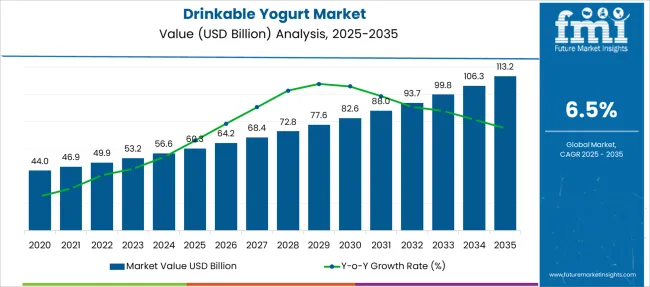
| Metric | Value |
|---|---|
| Drinkable Yogurt Market Estimated Value in (2025 E) | USD 60.3 billion |
| Drinkable Yogurt Market Forecast Value in (2035 F) | USD 113.2 billion |
| Forecast CAGR (2025 to 2035) | 6.5% |
The drinkable yogurt market is expanding steadily due to increasing health consciousness, demand for convenient nutrition, and rising interest in gut health. Consumers are seeking portable and protein-rich dairy options that support digestive wellness and align with busy lifestyles.
The market is also benefitting from innovations in flavor, texture, and probiotic enrichment, which enhance product appeal across various age groups. Manufacturers are leveraging advancements in cold chain logistics and packaging to preserve freshness and improve shelf stability, further supporting product accessibility.
As dietary trends shift toward functional and fortified beverages, drinkable yogurt continues to gain traction as a preferred choice among health-driven consumers. The outlook remains strong with growing investment in dairy alternatives, clean label formulations, and expanding retail presence across both urban and rural markets.
The market is segmented by Category, Type, and Sales Channel and region. By Category, the market is divided into Dairy-based yogurt and Non-dairy based yogurt. In terms of Type, the market is classified into Plain Yogurt and Drinkable Yogurt. Based on Sales Channel, the market is segmented into Offline Sales Channel and Online Sales Channel. Regionally, the market is classified into North America, Latin America, Western Europe, Eastern Europe, Balkan & Baltic Countries, Russia & Belarus, Central Asia, East Asia, South Asia & Pacific, and the Middle East & Africa.

The dairy based yogurt category is anticipated to contribute 56.30% of the total market revenue by 2025, making it the dominant category in the drinkable yogurt landscape. This is driven by its established consumer base, wide availability, and high nutritional value including essential proteins and calcium.
Consumers perceive dairy based yogurt as a wholesome and natural source of nutrition, particularly beneficial for digestive health due to its probiotic content. Continuous product innovations such as added vitamins, reduced sugar options, and lactose free variants are attracting health conscious buyers.
Strong supply chain networks and brand familiarity have also supported its continued dominance in both developed and emerging markets.
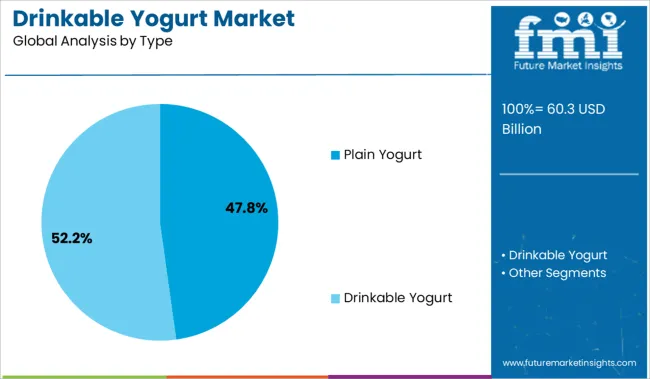
Plain yogurt within the drinkable segment is projected to account for 47.80% of the total market share in 2025, emerging as the leading type. This is largely attributed to rising demand for unsweetened and clean label products that allow consumers to personalize flavor through natural additions.
Health driven individuals are increasingly avoiding added sugars and artificial flavorings, making plain yogurt a preferred base. It is also widely used in smoothies, meal replacements, and dietary programs, enhancing its versatility.
The segment’s alignment with wellness trends and minimal processing has strengthened its position across both retail and institutional channels.
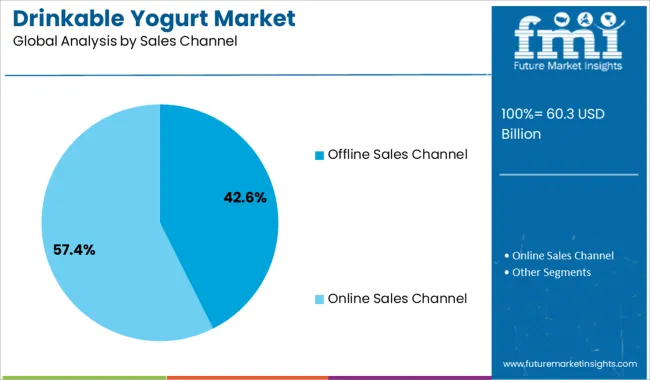
The offline sales channel is expected to contribute 42.60% of total market revenue by 2025, maintaining its lead in distribution. Supermarkets, convenience stores, and specialty retail outlets provide immediate product accessibility and refrigeration, key factors in preserving yogurt quality.
In store promotions, visibility, and brand presence have played a critical role in consumer purchasing decisions. Furthermore, impulse buying behavior and trust in physical product inspection have reinforced the relevance of offline retail in the drinkable yogurt category.
As consumer footfall returns to brick and mortar stores, the segment continues to serve as a vital touchpoint for brand interaction and sampling.
In order to maintain good health, consumers have increased the adoption of probiotics in their daily diet. Yogurt is one of the most favored prebiotics. As a result, the demand for drinkable yogurt is expected to rise in the near future.
Key players are focusing on introducing different flavors in order to appeal to a wide range of audiences. In order to utilize the consumer preference for plant-based product flavors like carrot and beetroot in addition to fruit-derived flavors like strawberry, coconut, and banana are easily available in the market. The drinkable yogurt market outlook is expected to shift the dairy consumption dynamics of consumers.
The drinkable yogurt market grew at a CAGR of 5.5% between 2020 and 2024. The period marked rapid product development, with the key players taking advantage of the significant opportunities being presented in the yogurt market.
As per the drinkable yogurt market study, consumers have reduced their intake of sugar in order to fulfill the demand of health-conscious consumers. As a result, stevia - a natural sweetener, is being adopted in drinkable yogurts. In order to maintain gut health, consumers are willing to spend on healthy eatables, thereby driving the sales of drinkable yogurt. All these factors are expected to propel the demand for drinkable yogurt in the market.
The easy availability of different types of drinkable yogurt in the market and consumer inclination toward health and wellness is expected to generate many opportunities in the drinkable yogurt market. Key players are focusing on developing beverages from organic ingredients as consumers prefer clean-label products.
Consumers are emphasizing the importance of maintaining good health and focusing on consuming food and beverages that help build body immunity. The demand for drinkable yogurt is rising as it has multiple functional ingredients.
A surge in the number of cases related to lifestyle illness has pushed consumers to buy healthy food products to maintain gut health. As consumers are aware of the benefits of including probiotic drinks to prevent gastrointestinal conditions like constipation, the demand for drinkable yogurt is expected to rise.
Packaging plays a crucial role in enhancing the shelf life of yogurt. Companies are sharing information related to processes and ingredients used in producing drinkable yogurt in order to maintain transparency to win over consumers. In order to entice consumers, key players are launching drinkable yogurt with additional functional properties and flavors. This marketing strategy being followed by the companies in the drinkable yogurt market is expected to yield favorable results.
As per the drinkable yogurt market analysis, consumers began to pay attention to their health during the pandemic, which led to their purchasing patterns changing significantly. This unexpected pandemic highlighted the importance of staying healthy in order to build resistance against invasive viruses. People began prioritizing the purchase of nutritious fluids, which further influenced the sales of drinkable yogurt.
Probiotics are included in people's everyday diets in order to maintain optimum health. In the coming years, this is projected to boost demand for drinkable yogurt drinks. In order to meet evolving consumer demands, many companies have introduced vegan, low-calorie, and gluten-free options.
Initially, due to the disruption of the supply chain, there was a scarcity of drinkable yogurts in the market. Travel restrictions and the closure of manufacturing industries further affected the sale of drinkable yogurts, but as the situation bounced back, people started spending on health-related products. The drinkable yogurt market has recovered from the pandemic and is expected to show a steady growth rate in the near future.
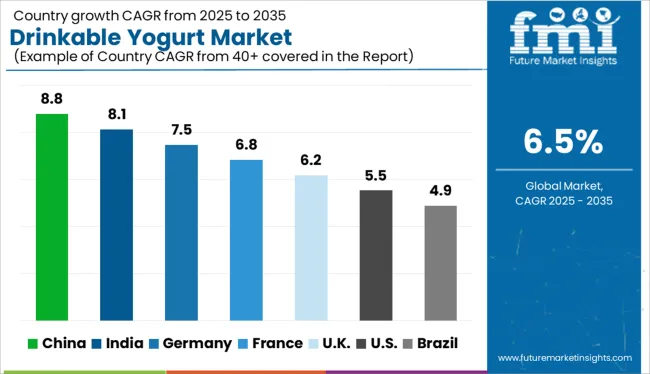
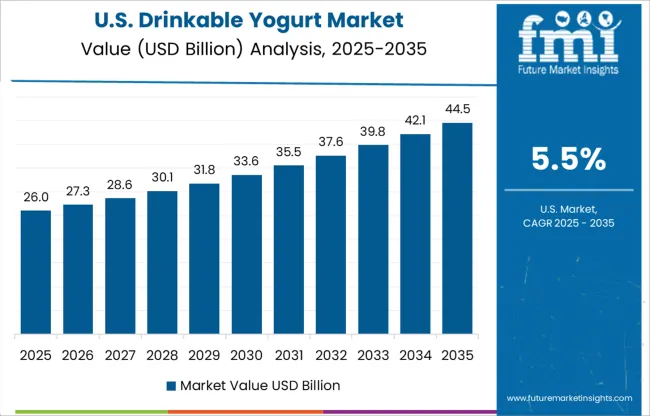
North America is at the forefront of the drinkable yogurt market due to the easy availability of the product. There is a regional presence of key players like Chobani and General Mills. They are launching sugar-free, vegan variants of drinkable yogurt in order to fulfill changing consumer requirements.
With the increase in consumer awareness, the demand for immunity-boosting food products has increased in the past few years. The younger generation is mindful of the food they eat and focuses on exercising daily, which in turn is expected to impact the demand for drinkable yogurts in North America. As per FMI, the USA drinkable yogurt market is expected to reach a value of about USD 60.3 Billion in 2025, which is approximately 24% of the global drinkable yogurt drinks market.
With a revenue share of 41.8 percent in 2024, Asia Pacific contributed the most to the worldwide drinkable yogurt market. This increase was attributed to increased product demand as a result of increased consumer knowledge of the need to eat a healthy diet.
Consumers' willingness to spend money on healthy snacks and beverages has aided producers in developing and producing a variety of beverages in the region. The growth in sales of drinkable yogurt will be fueled by key manufacturers' innovations. IFF, for example, developed YO-MIX ViV, a solution for ambient yogurt and other fermented drinks, with an emphasis on China, in June 2024.
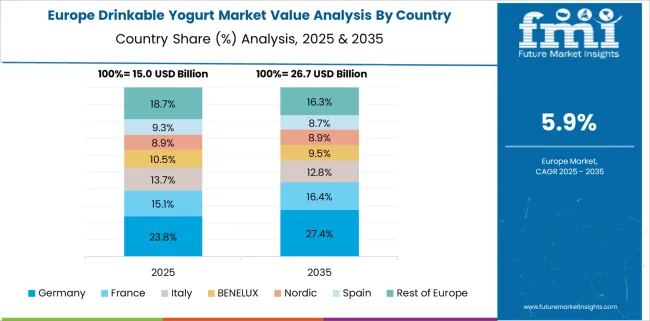
Consumers in European countries are well aware of the advantages of good health. They are willing to spend money on products that increase their body's resistance to viruses.
Drinkable yogurts are available in bottles and pouches of various sizes that are convenient to carry to work, which is projected to drive demand for drinkable yogurts among working people who prefer energy drinks to refill their energy after a long day at work.
Non-dairy yogurt accounted for the maximum share of the drinkable yogurt market. Plant-based drinks and desserts are a flourishing sector. It fits consumers’ desire to relish foods that are delicious, as well as good for their health.
Consumers are also preferring organic products that do not contain any chemical products and prefer brands that follow sustainable business practices. Like recyclable plastic packaging and low carbon footprint across different processes. Brands that offer vegan drinkable yogurt are expected to generate more revenue in long run.
Consumers have grown label cautious; they scrutinize all of the ingredients used to create healthy drinks. While standing in the aisles of the store, customers read the contents and choose drinks that contain elements that are good for them. And so considerable revenue generation comes through the sale of goods from fully stocked shelves in supermarkets. These shops have a large selection of drinkable yogurt in various flavors and pack sizes.
Customers can order drinks with only one click, which in itself is driving online sales. The online distribution channel in the drinkable yogurt market is expected to grow at a rate of 5.2 percent per year from 2025 to 2025. And they account for 60% of all sales.
To provide clients with doorstep delivery, key players partnered with several online marketplaces such as Amazon and Flipkart. Consumers are tempted to buy from online channels through various schemes and discounts offered by e-commerce sites. Many organizations are incorporating artificial intelligence and machine learning skills to improve the purchase experience on their platforms.
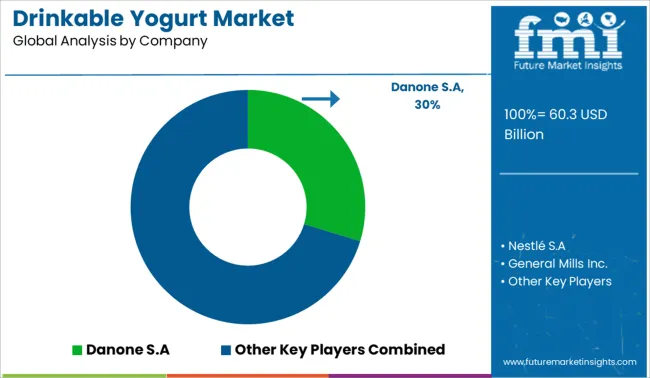
Key companies are investing in launching new products in the drinkable yogurts market to fulfill the consumer demand for healthy products. They are investing in developing technology and product packaging to enhance its shelf life.
| Attribute | Details |
|---|---|
| Forecast Period | 2025 to 2035 |
| Historical Data Available for | 2020 to 2024 |
| Market Analysis | USD Million for Value and lots for Volume |
| Key Regions Covered | North America; Latin America; Europe; East Asia; South Asia; and the Middle East & Africa |
| Key Countries Covered | USA, Brazil, Mexico, Germany, United Kingdom, China, India, Japan, Australia, and GCC Countries |
| Key Segments Covered | Category, Type, Sales Channel, and Region |
| Key Companies Profiled | Danone S.A; Nestlé S.A; General Mills Inc.; Chobani LLC; Royal FrieslandCampina N.V.; Groupe Lactalis; Pillars Yogurt; Morinaga Nutritional Foods, Inc |
| Report Coverage | Market Forecast, Company Share Analysis, Competition Intelligence, Drivers, Restraints, Opportunities and Threats Analysis, Market Dynamics and Challenges, and Strategic Growth Initiatives |
| Customization & Pricing | Available upon Request |
The global drinkable yogurt market is estimated to be valued at USD 60.3 billion in 2025.
The market size for the drinkable yogurt market is projected to reach USD 113.2 billion by 2035.
The drinkable yogurt market is expected to grow at a 6.5% CAGR between 2025 and 2035.
The key product types in drinkable yogurt market are dairy-based yogurt and non-dairy based yogurt.
In terms of type, plain yogurt segment to command 47.8% share in the drinkable yogurt market in 2025.






Full Research Suite comprises of:
Market outlook & trends analysis
Interviews & case studies
Strategic recommendations
Vendor profiles & capabilities analysis
5-year forecasts
8 regions and 60+ country-level data splits
Market segment data splits
12 months of continuous data updates
DELIVERED AS:
PDF EXCEL ONLINE
Yogurt Powder Market Analysis - Size, Share, and Forecast Outlook 2025 to 2035
Yogurt Dips Market Size, Growth, and Forecast for 2025 to 2035
Yogurt Market Analysis - Size, Share, & Forecast Outlook 2025 to 2035
Yogurt Maker Market – Trends, Growth & Forecast 2025 to 2035
Yogurt Packaging Market Trends – Growth & Demand Forecast 2025 to 2035
Yogurt And Probiotic Drink Market Analysis by Product Type, Source Type, and Region Through 2035
A2 Yogurt Market Trends – Growth, Demand & Innovations
Dry Yogurt Market Outlook - Growth, Demand & Forecast 2025 to 2035
Greek Yogurt Market Size and Share Forecast Outlook 2025 to 2035
Vegan Yogurt Market Size, Growth, and Forecast for 2025 to 2035
Japan Yogurt Powder Market Analysis by Product Type, Flavor, Nature, Application, End-Use, and Distribution Channel Through 2035
Frozen Yogurt Market Size and Share Forecast Outlook 2025 to 2035
Citrus Yogurt Market Insights – Flavor Trends & Consumer Demand 2025 to 2035
Analysis and Growth Projections for Savory Yogurt Market
Non-GMO yogurt Market Analysis by Product Type, By End use, By Distribution Channel of the and End User Through 2035
Flavored Yogurt Market Analysis by Form, Flavor, End Use and Distribution Channel Through 2035
Non-Dairy Yogurt Market Analysis - Size, Share, and Forecast Outlook 2025 to 2035
Probiotic Yogurt Market Analysis - Size, Share & Forecast 2025 to 2035
Plant-based Yogurt Market Analysis - Size, Share, and Forecast 2025 to 2035
High Protein Yogurt Market Trends - Growth & Industry Forecast 2025 to 2035

Thank you!
You will receive an email from our Business Development Manager. Please be sure to check your SPAM/JUNK folder too.
Chat With
MaRIA